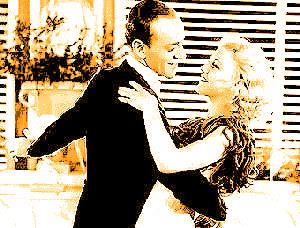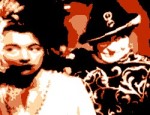Film Review
It would be stretching it to say that it was Hollywood alone that got
America through the worst of the Great Depression but, by regularly
turning out frothy musical extravaganzas such as this, the wizards in
Tinseltown certainly helped to ease the pain.
The Gay Divorcee is the film that
cemented one of the silver screen's legendary partnerships, that of
Fred Astaire and Ginger Rogers, the most famous dancing duo in
history. The pair had previously appeared together briefly in a
dance routine in
Flying Down to Rio
(1933), but it wasn't until they were reunited in a film of their own
that they found enduring fame, and a massive
audience.
This film was loosely adapted from a popular Broadway musical entitled
The Gay Divorce, which had featured
Fred Astaire starring opposite Claire Luce. The Hays Office
(Hollywood's over-zealous self-censorship department) insisted that an
extra 'e' be added to the last word of the title, since it was
considered improper to suppose that a divorce could ever be a happy
affair. The only Cole Porter number of the original show to make
it into the film was
Night and Day,
which became a popular hit.
The centrepiece of the film is a stunning 17-minute long dance routine
that featured 40 couples, accompanying the hit song
The Continental (written by Con
Conrad and Herb Magidson). No film had previously included such a
protracted dance number and the song was the first to win the Best Song
Oscar. (The Film was nominated for Oscars in four other
categories, including Best Picture and Best Art Direction.)
At the time, RKO were unsure whether Astaire and Rogers could carry the
film, so two comedy heavyweights, Alice Brady and Edward Everett
Horton, were hired to share the load. The former two provide the
glamour and romance; the latter were there simply to make audiences
laugh. It was a winning combination and RKO employed the same
unbeatable team in a similar film,
Top Hat (1935), also directed
by Mark Sandrich, and scored another notable success.
It is not difficult to see why
The
Gay Divorcee was so popular. With its marvellously
choreographed song and dance routines and extravagant Art Deco sets,
the film positively reeks of style and decadence. And for those
looking for humour, the film has it in abundance, with Astaire knocking
out the gags as effortlessly as he taps his feet. Here's the
ultimate feel-good film, one that is guaranteed to chase away the blues
and transport you to happier climes, an invitation to moonlight and
romance...
© James Travers 2009
The above content is owned by frenchfilms.org and must not be copied.
Film Synopsis
After a brief stay in Paris, the celebrated American dancer Guy Holden
travels to England with his friend, Egbert Fitzgerald, a lawyer who has
agreed to temporarily take the reins at his father's London law
firm. As he passes through customs, Guy meets an attractive young
American woman, Mimi, and becomes obsessed with seeing her again.
Having contrived to meet Mimi in London, he soon loses sight of her but
cannot get her out of his head. Meanwhile, Egbert has accepted a
divorce case and takes Guy with him down to Brighton to arrange for his
client to be discovered making love to a man who is not her husband,
thereby providing grounds for divorce. The divorcee in question
is none other than Mimi and the co-respondent is intended to be an
Italian dandy named Rodolfo Tonetti whom Egbert has hired. Things
take a complicated and near-disastrous turn when Tonetti goes astray
and Mimi mistakes Guy for her co-respondent...
© James Travers
The above content is owned by frenchfilms.org and must not be copied.



